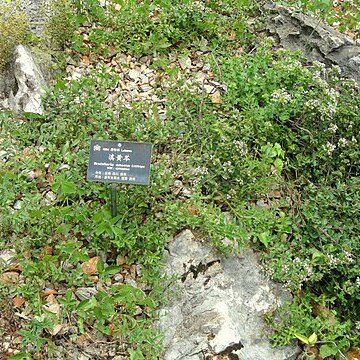Herbs perennial. Rootstocks at least 1.1 cm in diam., forked. Stems purplish, numerous, erect, 12-26(-35) cm tall, retrorsely to spreading puberulent to pilose along angles. Petiole 1-2 mm; leaf blade oblong-ovate to oblong, 1.4-3.3 × 0.7-1.4 cm at mid and upper parts of stem, smaller basally, folded, herbaceous, sparsely puberulent to subglabrous, base rounded to shallowly cordate, margin inconspicuously crenate to entire, apex rounded to obtuse. Racemes terminal, 5-14 cm, mostly glandular puberulent; bracts reduced upward, lanceolate-oblong, 5-10 mm, base cuneate, apex acute to obtuse. Pedicel 3-4 mm. Calyx purplish, ca. 3 mm, to 5 mm in fruit; scutellum ca. 1 mm, to 3 mm in fruit. Corolla purple or blue-purple, 2.4-3 cm, glabrous inside; tube base slightly saccate, conspicuously bent, throat to 7 mm wide; middle lobe of lower lip subcircular, to 1 cm wide, margin subentire; lateral lobes triangular, ca. 3 mm wide. Nutlets black, ovoid, ca. 1.25 × 1 mm, tuberculate, adaxially umbonate near base. Fl. May-Sep, fr. Jul-Oct.
More
A herb. It keeps growing from year to year. It grows 20-60 cm high. There is a short stout stem attached to the taproot. It is golden yellow inside. The leaves are opposite. They are narrowly sword shaped and 2-5 cm long by 3-12 mm wide. The flowers are reddish-purple. They occur singly in the axils of small leaves.
It grows on open hillsides in northern and western China. It grows in grasslands and pine forests between 1,300-3,000 m above sea level. In Sichuan and Yunnan.
The leafy branches are gathered, steamed, dried in the shade and mixed with Ephedra sinica to make tea.

